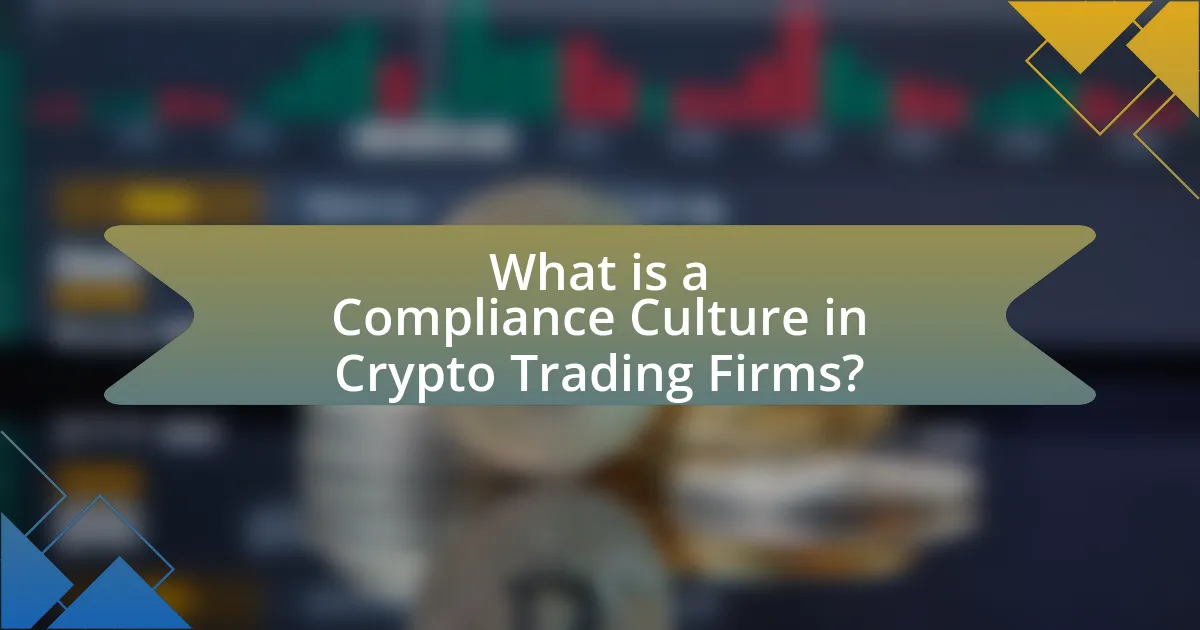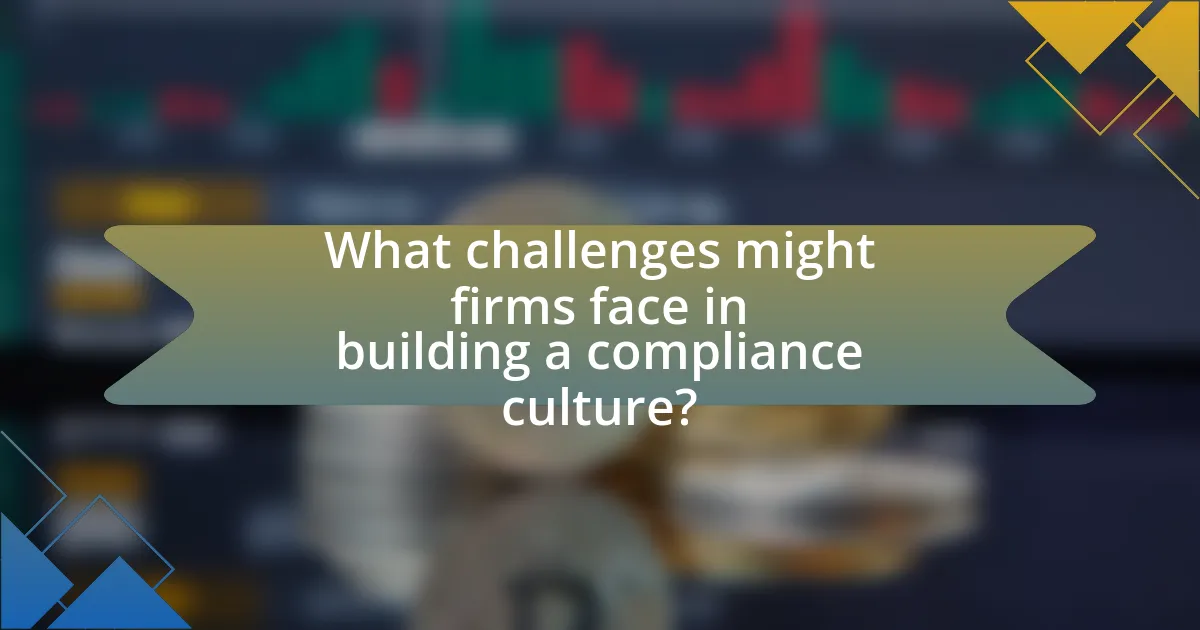A compliance culture in crypto trading firms is an organizational framework that emphasizes adherence to legal and regulatory standards, including anti-money laundering (AML) and know your customer (KYC) regulations. This article outlines the importance of fostering such a culture to mitigate risks, enhance business reputation, and ensure ethical practices within the industry. Key components of a compliance culture include leadership commitment, clear policies, employee training, and continuous monitoring. The article also discusses the challenges firms may face in building this culture, strategies for implementation, and the role of technology in supporting compliance efforts.

What is a Compliance Culture in Crypto Trading Firms?
A compliance culture in crypto trading firms refers to an organizational environment that prioritizes adherence to legal and regulatory standards in all trading activities. This culture is characterized by a commitment to ethical practices, transparency, and accountability, ensuring that all employees understand and comply with relevant laws, such as anti-money laundering (AML) and know your customer (KYC) regulations. Research indicates that firms with a strong compliance culture are better equipped to mitigate risks associated with regulatory breaches, which can lead to significant financial penalties and reputational damage. For instance, a study by the Financial Action Task Force (FATF) highlights that effective compliance frameworks can reduce the likelihood of illicit activities within the crypto space, thereby fostering trust among stakeholders and enhancing market integrity.
Why is a Compliance Culture important in the crypto trading industry?
A Compliance Culture is crucial in the crypto trading industry because it fosters trust, mitigates risks, and ensures adherence to regulatory standards. This culture promotes ethical behavior among employees, which is essential in an industry often scrutinized for its lack of oversight. For instance, a strong compliance framework can help prevent money laundering and fraud, as evidenced by the Financial Action Task Force’s recommendations that emphasize the importance of compliance in financial sectors, including cryptocurrencies. By prioritizing compliance, firms can enhance their reputation, attract institutional investors, and avoid costly penalties associated with regulatory violations.
What risks are associated with a lack of compliance culture?
A lack of compliance culture in organizations, particularly in crypto trading firms, poses significant risks including legal penalties, financial losses, and reputational damage. Legal penalties arise from non-compliance with regulations such as anti-money laundering (AML) and know your customer (KYC) laws, which can lead to hefty fines and sanctions from regulatory bodies. Financial losses can occur due to fraud, market manipulation, or operational inefficiencies that arise when compliance is not prioritized. Reputational damage can severely impact customer trust and investor confidence, leading to a decline in business and market position. For instance, the Financial Action Task Force (FATF) has emphasized that firms lacking robust compliance frameworks are more susceptible to illicit activities, which can result in severe consequences for their operations.
How does compliance culture impact business reputation?
Compliance culture significantly enhances business reputation by fostering trust and credibility among stakeholders. When a company prioritizes compliance, it demonstrates a commitment to ethical practices and regulatory adherence, which can lead to positive perceptions from customers, investors, and regulators. For instance, a study by the Ethics & Compliance Initiative found that organizations with strong compliance cultures experience 50% fewer incidents of misconduct, which directly correlates with improved public image and stakeholder confidence. This positive reputation can result in increased customer loyalty, better employee morale, and ultimately, enhanced financial performance.
What are the key components of a compliance culture?
The key components of a compliance culture include leadership commitment, clear policies and procedures, employee training, effective communication, and continuous monitoring and improvement. Leadership commitment establishes the tone at the top, ensuring that compliance is prioritized throughout the organization. Clear policies and procedures provide a framework for expected behaviors and compliance requirements. Employee training equips staff with the knowledge to adhere to these policies, while effective communication fosters an environment where compliance is openly discussed. Continuous monitoring and improvement allow organizations to adapt to changing regulations and enhance their compliance efforts. These components collectively create a robust compliance culture essential for mitigating risks in crypto trading firms.
How do policies and procedures shape compliance culture?
Policies and procedures shape compliance culture by establishing clear expectations and guidelines for behavior within an organization. These frameworks provide a structured approach to compliance, ensuring that employees understand their roles and responsibilities in adhering to legal and regulatory standards. For instance, a study by the Ethics & Compliance Initiative found that organizations with well-defined policies experience a 30% reduction in compliance violations compared to those without such frameworks. This demonstrates that effective policies and procedures not only promote accountability but also foster an environment where ethical behavior is prioritized, ultimately enhancing the overall compliance culture within crypto trading firms.
What role does employee training play in fostering compliance?
Employee training plays a crucial role in fostering compliance by equipping employees with the knowledge and skills necessary to understand and adhere to regulatory requirements. Effective training programs ensure that employees are aware of compliance policies, legal obligations, and the potential consequences of non-compliance, thereby reducing the risk of violations. Research indicates that organizations with comprehensive compliance training programs experience a 50% reduction in compliance violations compared to those without such training. This highlights the importance of ongoing education in maintaining a culture of compliance within crypto trading firms.
How can leadership influence compliance culture?
Leadership can significantly influence compliance culture by establishing clear expectations and modeling ethical behavior. When leaders prioritize compliance, they create an environment where adherence to regulations is valued and integrated into daily operations. For instance, a study by the Ethics & Compliance Initiative found that organizations with strong leadership commitment to compliance experience 50% fewer incidents of misconduct. This demonstrates that effective leadership not only sets the tone for compliance but also fosters a culture of accountability and transparency, essential for the integrity of crypto trading firms.
What leadership styles are most effective in promoting compliance?
Transformational leadership and transactional leadership are the most effective styles in promoting compliance. Transformational leaders inspire and motivate employees to embrace compliance as part of the organizational culture, fostering a sense of ownership and accountability. This style has been shown to enhance employee engagement and commitment to compliance standards, as evidenced by a study published in the Journal of Business Ethics, which found that transformational leadership positively correlates with ethical behavior in organizations.
On the other hand, transactional leadership emphasizes clear structures, rules, and rewards for compliance, ensuring that employees understand the consequences of non-compliance. Research from the International Journal of Management Reviews indicates that transactional leadership can effectively enforce compliance through established protocols and performance metrics. Together, these leadership styles create a robust framework for fostering a compliance culture in crypto trading firms.
How can leaders model compliance behavior for employees?
Leaders can model compliance behavior for employees by consistently demonstrating adherence to regulations and ethical standards in their own actions. When leaders prioritize compliance in decision-making and openly communicate the importance of following rules, they set a clear example for employees to emulate. Research shows that organizations with visible leadership commitment to compliance experience higher levels of employee adherence to policies, as employees are more likely to follow the behaviors exhibited by their leaders. For instance, a study published in the Journal of Business Ethics found that ethical leadership significantly influences employees’ compliance behavior, reinforcing the idea that leaders’ actions directly impact the overall compliance culture within an organization.

What strategies can be implemented to build a compliance culture?
To build a compliance culture in crypto trading firms, organizations should implement comprehensive training programs that educate employees on regulatory requirements and ethical standards. These programs should be tailored to the specific challenges of the crypto industry, ensuring that all staff understand the importance of compliance in maintaining the firm’s integrity and reputation. Research indicates that companies with robust training initiatives see a 50% reduction in compliance violations, highlighting the effectiveness of education in fostering a culture of compliance. Additionally, establishing clear policies and procedures, along with regular audits and assessments, reinforces accountability and encourages adherence to compliance standards.
How can organizations assess their current compliance culture?
Organizations can assess their current compliance culture by conducting comprehensive surveys and interviews with employees at all levels to gauge their understanding and attitudes towards compliance policies. This method allows organizations to collect quantitative and qualitative data on employee perceptions, which can reveal gaps in knowledge and areas needing improvement. For instance, a study by the Ethics & Compliance Initiative found that organizations with strong compliance cultures report higher employee engagement and lower instances of misconduct, highlighting the importance of assessing compliance culture for overall organizational health.
What tools can be used for compliance culture assessment?
Tools that can be used for compliance culture assessment include surveys, interviews, focus groups, and compliance audits. Surveys allow organizations to gather quantitative data on employee perceptions of compliance, while interviews and focus groups provide qualitative insights into the cultural aspects of compliance. Compliance audits assess adherence to regulations and internal policies, offering a comprehensive view of the compliance culture. These tools collectively enable firms to evaluate their compliance culture effectively, ensuring alignment with regulatory standards and internal values.
How can feedback from employees inform compliance strategies?
Feedback from employees can significantly inform compliance strategies by providing insights into the effectiveness of existing policies and identifying potential areas for improvement. Employees, being on the front lines, can highlight practical challenges they face in adhering to compliance measures, which can lead to more tailored and effective strategies. For instance, a survey conducted by the Ethics & Compliance Initiative found that organizations with strong employee feedback mechanisms reported 30% higher compliance effectiveness. This data underscores the importance of integrating employee perspectives into compliance frameworks to enhance adherence and foster a culture of accountability.
What best practices should be followed in developing compliance programs?
To develop effective compliance programs, organizations should implement a risk-based approach that identifies and prioritizes compliance risks specific to their operations. This involves conducting thorough risk assessments to understand potential vulnerabilities and regulatory requirements relevant to the crypto trading sector. Additionally, organizations should establish clear policies and procedures that align with legal standards and industry best practices, ensuring that all employees are trained on these guidelines. Regular monitoring and auditing of compliance activities are essential to evaluate the effectiveness of the program and to make necessary adjustments. Furthermore, fostering a culture of transparency and accountability within the organization encourages employees to report compliance issues without fear of retaliation. These practices are supported by the Financial Action Task Force (FATF) recommendations, which emphasize the importance of a robust compliance framework in mitigating risks associated with money laundering and terrorist financing in the crypto industry.
How can organizations ensure ongoing compliance training?
Organizations can ensure ongoing compliance training by implementing a structured training program that includes regular updates, assessments, and feedback mechanisms. This approach allows organizations to adapt to changing regulations and industry standards effectively. For instance, a study by the Society for Human Resource Management found that organizations with continuous training programs experience a 50% higher compliance rate compared to those with infrequent training. Additionally, utilizing technology such as Learning Management Systems (LMS) can facilitate the delivery of training materials and track employee progress, ensuring that all staff remain informed about compliance requirements.
What methods can be used to communicate compliance expectations?
Effective methods to communicate compliance expectations include training sessions, written policies, and regular updates. Training sessions provide employees with the necessary knowledge and skills to understand compliance requirements, while written policies serve as a reference point for expected behaviors and procedures. Regular updates, such as newsletters or meetings, reinforce compliance messages and keep employees informed about any changes in regulations or company policies. These methods ensure that compliance expectations are clearly articulated and understood within the organization, fostering a culture of adherence to regulatory standards.
What role does technology play in enhancing compliance culture?
Technology plays a crucial role in enhancing compliance culture by automating processes, improving data accuracy, and facilitating real-time monitoring. Automation reduces human error and increases efficiency in compliance tasks, such as transaction monitoring and reporting. For instance, advanced analytics and machine learning algorithms can identify suspicious activities more effectively than manual methods, thereby strengthening compliance efforts. Additionally, technology enables organizations to maintain comprehensive records and documentation, which is essential for audits and regulatory reviews. According to a report by the Association of Certified Financial Crime Specialists, firms that leverage technology for compliance see a 30% reduction in compliance-related costs and a significant improvement in adherence to regulations. This demonstrates that technology not only streamlines compliance processes but also fosters a culture of accountability and transparency within organizations.
How can compliance software support a culture of compliance?
Compliance software can support a culture of compliance by automating regulatory processes and ensuring adherence to legal standards. By providing tools for real-time monitoring, documentation, and reporting, compliance software enables organizations to maintain transparency and accountability. For instance, a study by the Association of Certified Fraud Examiners found that organizations with automated compliance systems experience a 30% reduction in compliance-related incidents. This reduction fosters a proactive compliance environment, encouraging employees to prioritize ethical practices and adhere to established guidelines.
What are the benefits of using blockchain for compliance tracking?
The benefits of using blockchain for compliance tracking include enhanced transparency, improved data integrity, and streamlined audit processes. Blockchain technology provides a decentralized ledger that records all transactions in a tamper-proof manner, ensuring that compliance data is accurate and easily verifiable. This transparency allows regulatory bodies and internal auditors to access real-time information, reducing the time and resources needed for audits. Additionally, the immutable nature of blockchain records minimizes the risk of data manipulation, thereby increasing trust among stakeholders. According to a report by Deloitte, 83% of organizations believe that blockchain can enhance compliance and regulatory processes, highlighting its effectiveness in fostering a robust compliance culture in crypto trading firms.

What challenges might firms face in building a compliance culture?
Firms may face several challenges in building a compliance culture, including resistance to change, lack of employee engagement, and insufficient resources. Resistance to change often stems from established practices and a reluctance to adopt new compliance protocols, which can hinder the implementation of effective compliance measures. Lack of employee engagement can result in a disconnect between compliance objectives and daily operations, leading to non-compliance. Insufficient resources, both in terms of personnel and financial investment, can limit the ability to develop and maintain a robust compliance framework. According to a study by the Association of Certified Fraud Examiners, organizations with strong compliance cultures experience 50% fewer incidents of fraud, highlighting the importance of overcoming these challenges to foster a successful compliance environment.
What common obstacles hinder the development of compliance culture?
Common obstacles that hinder the development of compliance culture include lack of leadership commitment, insufficient training, and inadequate communication. Leadership commitment is crucial; without it, employees may not prioritize compliance, leading to a culture that undervalues regulatory adherence. Insufficient training results in employees being unaware of compliance requirements, which can lead to unintentional violations. Inadequate communication can create misunderstandings about compliance policies, further complicating adherence. These factors collectively contribute to a weak compliance culture, as evidenced by studies showing that organizations with strong leadership support and effective training programs are more likely to maintain high compliance standards.
How can resistance to change be addressed in compliance initiatives?
Resistance to change in compliance initiatives can be addressed by fostering open communication and involving employees in the change process. Engaging employees through discussions about the reasons for compliance changes helps to alleviate fears and misconceptions. Research indicates that organizations that prioritize employee involvement in decision-making experience a 30% higher success rate in implementing change initiatives. Additionally, providing training and resources equips employees with the knowledge and skills necessary to adapt, further reducing resistance.
What strategies can mitigate the impact of resource constraints?
To mitigate the impact of resource constraints in crypto trading firms, implementing prioritization of compliance activities is essential. This strategy involves identifying critical compliance areas that require immediate attention and allocating resources accordingly. For instance, firms can conduct a risk assessment to determine which compliance obligations pose the highest risk and focus their limited resources on those areas. Additionally, leveraging technology, such as compliance automation tools, can enhance efficiency and reduce manual workload, allowing firms to maximize their output with fewer resources. Research indicates that firms utilizing automated compliance solutions can reduce operational costs by up to 30%, demonstrating the effectiveness of this approach.
How can firms measure the effectiveness of their compliance culture?
Firms can measure the effectiveness of their compliance culture through employee surveys, compliance audits, and incident tracking. Employee surveys assess perceptions of compliance policies and ethical behavior, providing insights into the cultural climate. Compliance audits evaluate adherence to regulations and internal policies, revealing gaps and areas for improvement. Incident tracking monitors compliance breaches and responses, offering data on the effectiveness of training and policy enforcement. Research indicates that organizations with strong compliance cultures experience fewer violations and enhanced employee engagement, demonstrating the correlation between a positive compliance culture and operational success.
What metrics are useful for evaluating compliance culture success?
Useful metrics for evaluating compliance culture success include employee training completion rates, incident reporting frequency, and employee feedback on compliance policies. Employee training completion rates indicate how well staff understand compliance requirements, with a higher percentage reflecting a stronger culture. Incident reporting frequency shows the willingness of employees to report unethical behavior, which is essential for a transparent compliance environment. Additionally, employee feedback on compliance policies can provide insights into how well these policies are understood and accepted, with positive feedback suggesting a robust compliance culture. These metrics collectively help organizations assess and enhance their compliance culture effectively.
How can employee engagement surveys contribute to compliance assessment?
Employee engagement surveys can significantly contribute to compliance assessment by providing insights into employees’ understanding of compliance policies and their perceptions of the organizational culture. These surveys can reveal gaps in knowledge or awareness regarding compliance requirements, which can be critical for identifying areas needing improvement. For instance, a study by the Ethics & Compliance Initiative found that organizations with high employee engagement levels are more likely to have effective compliance programs, as engaged employees are more likely to adhere to policies and report unethical behavior. This correlation underscores the importance of using engagement surveys as a tool to assess and enhance compliance culture within organizations, particularly in sectors like crypto trading, where regulatory adherence is paramount.
What are the practical steps for implementing a compliance culture?
To implement a compliance culture in crypto trading firms, organizations should take the following practical steps: establish clear compliance policies, provide regular training, promote open communication, integrate compliance into business processes, and monitor compliance effectiveness.
Establishing clear compliance policies involves defining rules and regulations that align with legal requirements and industry standards, ensuring that all employees understand their responsibilities. Regular training sessions educate employees on compliance issues, fostering awareness and understanding of the importance of adherence to policies. Promoting open communication encourages employees to report concerns without fear of retaliation, creating a transparent environment. Integrating compliance into business processes ensures that compliance considerations are part of everyday operations, making it a fundamental aspect of the firm’s culture. Finally, monitoring compliance effectiveness through audits and assessments allows firms to identify gaps and improve their compliance strategies continuously.
These steps are supported by the fact that organizations with strong compliance cultures tend to experience fewer regulatory violations and enhanced reputational integrity, as evidenced by studies showing that proactive compliance measures can reduce the risk of legal penalties and foster trust among clients and stakeholders.
How can firms create a roadmap for compliance culture development?
Firms can create a roadmap for compliance culture development by establishing clear policies, providing ongoing training, and fostering open communication. Clear policies outline expectations and responsibilities, ensuring all employees understand compliance requirements. Ongoing training programs keep staff updated on regulatory changes and reinforce the importance of compliance. Fostering open communication encourages employees to report concerns without fear of retaliation, thereby promoting a culture of transparency. Research indicates that organizations with strong compliance cultures experience fewer regulatory violations and enhanced reputational integrity, demonstrating the effectiveness of these strategies in building a robust compliance framework.
What role does continuous improvement play in compliance culture?
Continuous improvement is essential in fostering a robust compliance culture as it ensures that compliance practices evolve in response to changing regulations and market conditions. By systematically assessing and enhancing compliance processes, organizations can identify gaps, mitigate risks, and adapt to new legal requirements, thereby reinforcing their commitment to ethical standards. For instance, firms that implement regular training and feedback mechanisms demonstrate a proactive approach to compliance, which has been shown to reduce violations and enhance overall organizational integrity.















